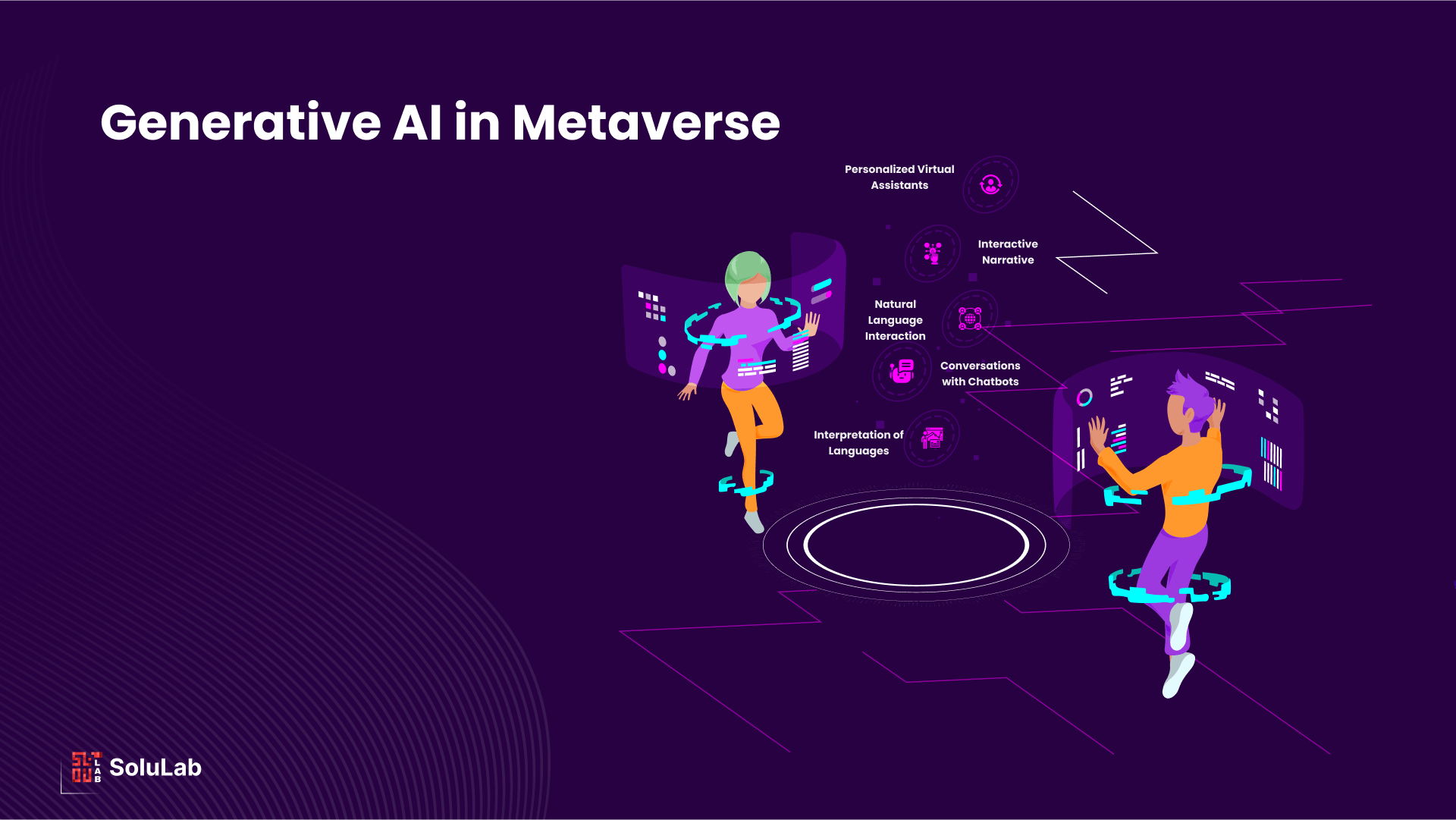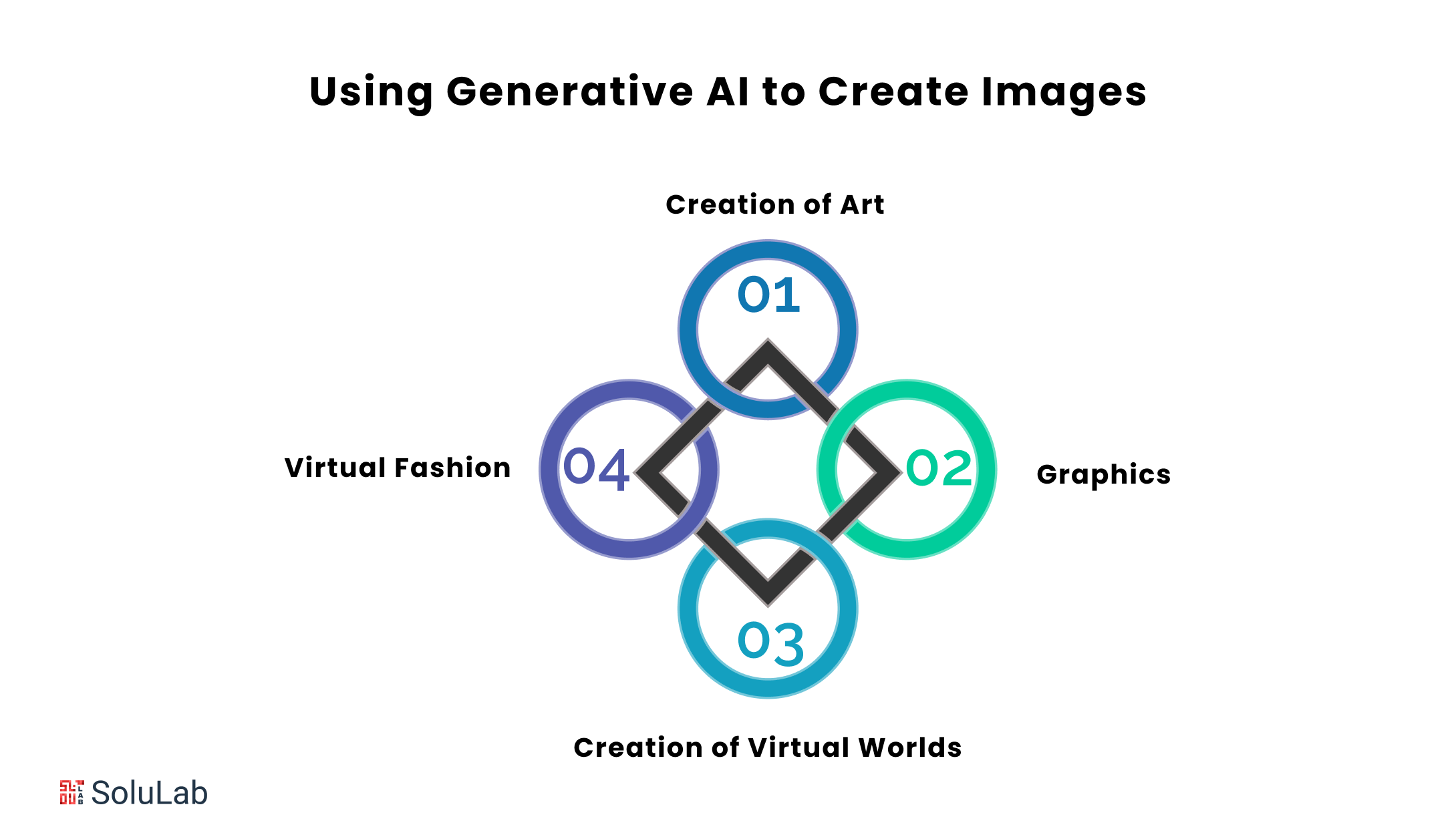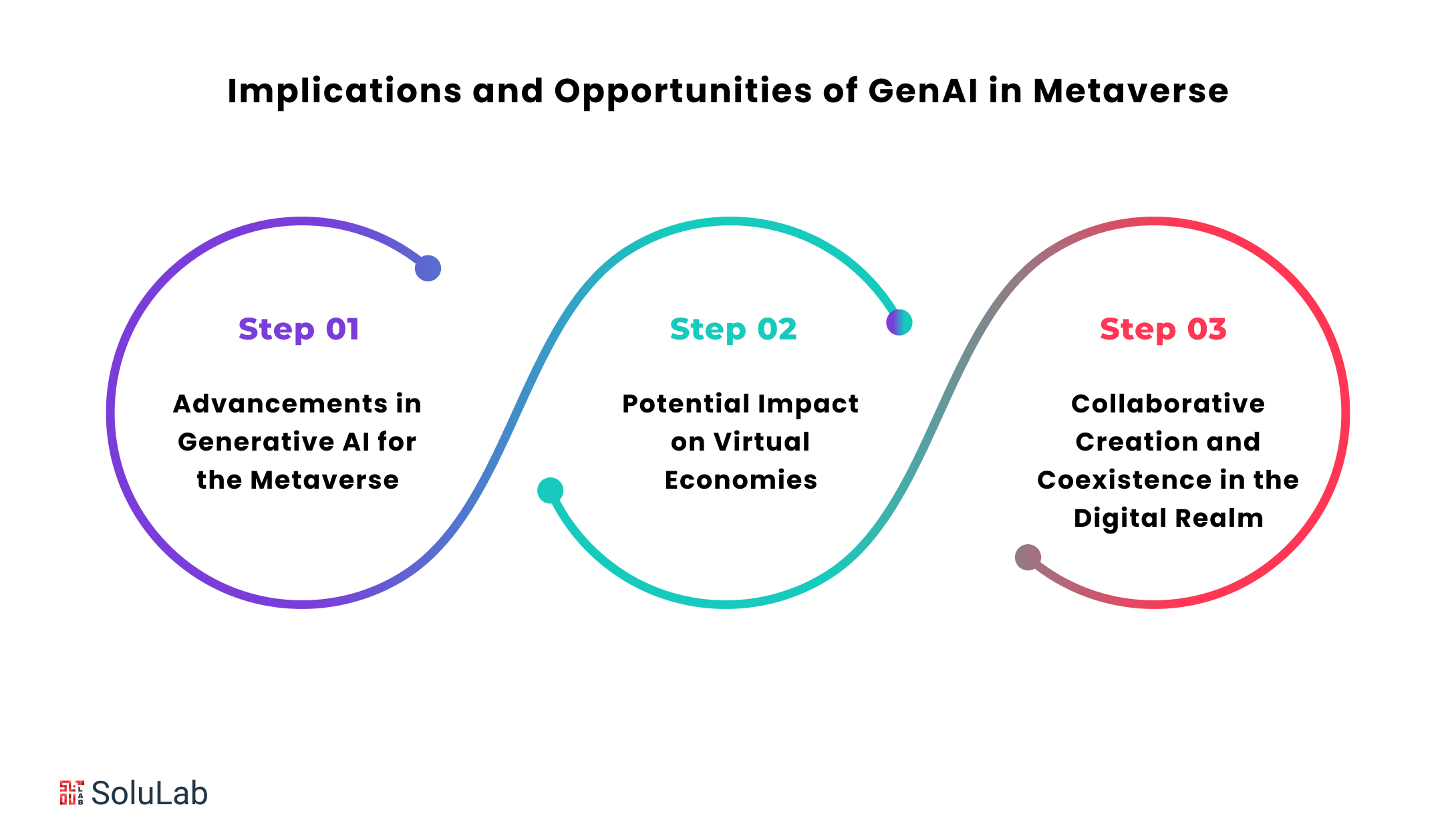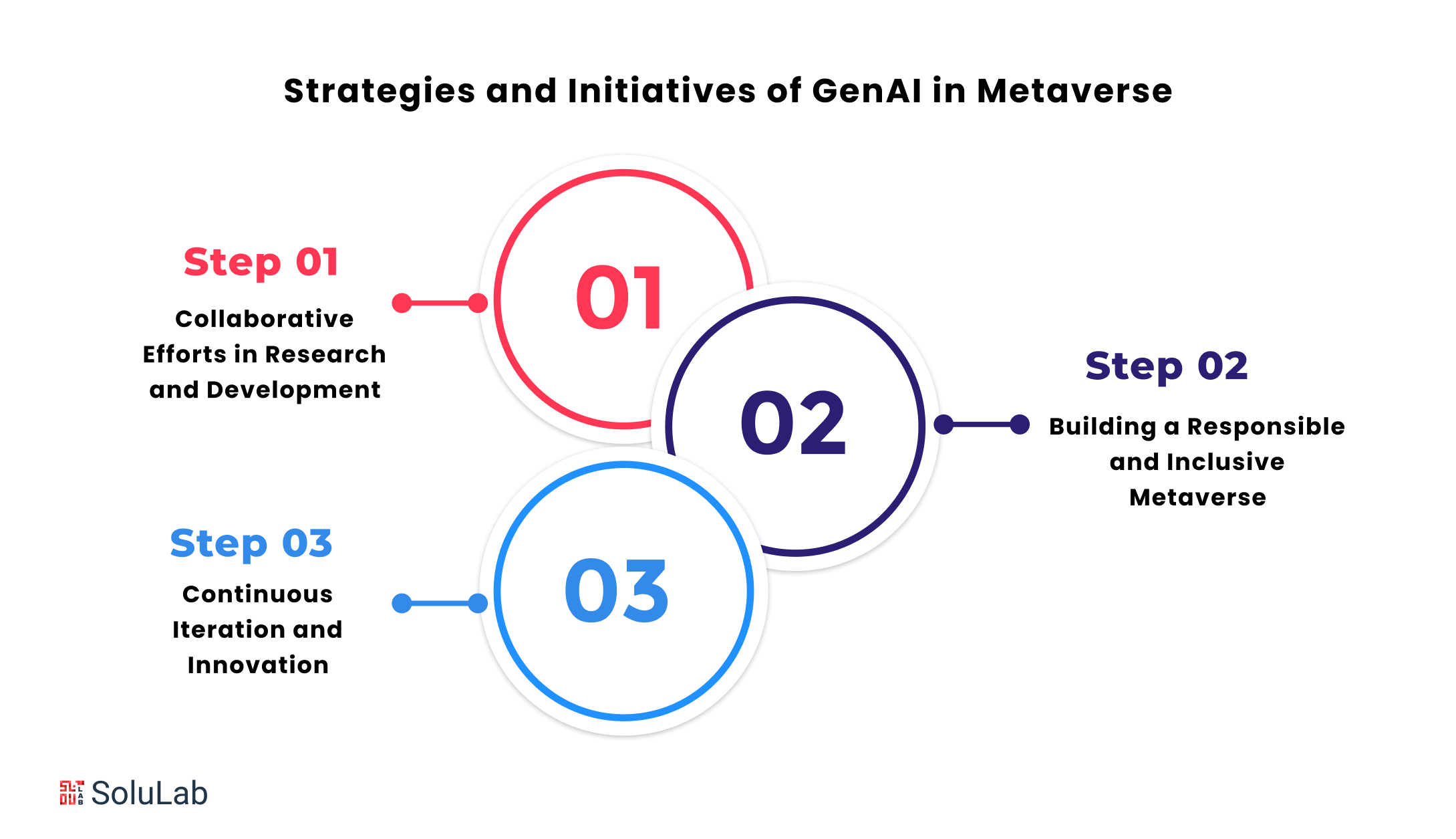
Generative AI is the most common type of artificial intelligence mentioned in conversations about new technological advancements. It is a kind of artificial intelligence that can generate new material autonomously, including video, photos, audio, and text. Interestingly, the potential for the use of generative AI in the metaverse has received a lot of interest. Generative AI has the potential to bring unique and novel techniques to content generation in the Metaverse.
For example, generative AI technologies such as ChatGPT might improve search experiences, rethink methods of creating and presenting content, and open up new avenues for internet traffic. It has the potential to affect established metaverse solutions while also increasing industrial innovation. In this blog, let’s look at how generative AI might have a huge impact on the metaverse.
The Connection Between Metaverse and Generative AI
By examining the connection between the two concepts, you may discover more about the effects of generative AI in the metaverse. Users can engage with one another in the vast array of immersive virtual locations that make up the Metaverse, a virtual universe. You could consider AI’s function in the metaverse and its possible advantages.
It’s crucial to remember that how well immersive and interactive experiences work determines how useful the metaverse is. In addition to enabling brand-new and creative interactions with material, the metaverse facilitates interpersonal connections, communication, and engagement. It’s interesting to note that modern advances in AI are entwined with the future of metaverse technology.
The development of artificial intelligence may have a significant impact on how the metaverse develops. How? Artificial Intelligence (AI) is a crucial instrument for the metaverse of the future, since it may improve user experiences by facilitating intelligent interactions and content generation automation. You need to understand the importance of generative AI for the metaverse if you want to know the answers to questions like “What is AI metaverse?” The development of dynamic virtual worlds, realistic virtual content, and efficient experience customization are all possible with the aid of generative artificial intelligence.
It is essential for providing fresh experiences in the metaverse and for raising user engagement. Generative artificial intelligence (AI) has the potential to facilitate the creation of vast and varied virtual worlds, landscapes, and architecture inside the metaverse.
Consequently, generative AI may guarantee distinct user experiences throughout the many virtual realms inside the metaverse.
The Potential for Revolution in Generative AI
A revolutionary idea that has the potential to combine elements of virtual and actual reality is the metaverse. It creates fresh chances for consumers to review their online interactions with other people in virtual settings. However, generative AI difficulties also give metaverse developers serious cause for concern.
Generative AI has the potential to significantly contribute to the growth of the metaverse by enabling immersive experiences, tailored interactions, and content creation. Future prospects for commerce, social relationships, entertainment, and other fields may arise from the successful integration of generative AI in the metaverse.
How does generative AI’s transformational power function in the metaverse? Text generation, video generation, picture generation, and 3D object production are the four key components in the metaverse’s evolution. These four areas might be improved with the help of generative AI technologies, improving the user experience as a whole.
Text Generation Automation in the Metaverse
The automated creation of text for the metaverse to enhance experiences might be supported by the technical use cases of generative AI. The creation of content, chatbot interactions, language translation, and interactive storytelling are a few of the most popular applications of generative AI for text production in the metaverse. Immersive, dynamic, and customized textual interactions in virtual metaverse settings might be made possible by generative AI. This is a summary of the several ways that generative AI might enhance metaverse text production.
-
Interpretation of Languages
Translation across languages in the metaverse could be possible in real-time through the use of sequence-to-sequence models, like Google Neural Machine Translation. Therefore, generative AI’s potential to facilitate smooth multilingual communication is evident from the function of AI in the metaverse.
-
Conversations with Chatbots
Dynamic talks in the metaverse can be facilitated by automated AI-powered chatbots such as GPT. Furthermore, generative AI algorithms may guarantee that chatbots in the metaverse provide responses that are appropriate for the given context. Chatbots that function as virtual assistants, for instance, might lead players through their experience of metaverse games.
-
Natural Language Interaction
In the metaverse, generative AI models also enhance natural language interaction. Therefore, using AI-based avatars, generative AI may provide dynamic and lifelike interactions. On a virtual social network within the metaverse, for instance, people might engage in lifelike dialogues with one another.
-
Interactive Narrative
One well-known example of solving generative AI issues in the metaverse is interactive storytelling. Narrative-generating techniques might be employed by generative AI models to enable interactive storytelling within the metaverse. Based on user inputs and particular choices, the models produce compelling and cohesive tales. For example, player choices in virtual role-playing games within the metaverse may have an impact on the game’s plot.
-
Personalized Virtual Assistants
The potential for improving the metaverse through generative AI also suggests that deploying individualized virtual assistants may be done with flexibility. For example, virtual assistants might be trained to recognize significant user preferences, provide suggestions for virtual experiences, and support users as they navigate the metaverse.
Using Generative AI to Create Images

Image creation is the next noteworthy way that generative AI is affecting the metaverse. The use of modern machine learning techniques in generative AI picture synthesis has great promise for enhancing the metaverse. The answers to the question, “What is AI metaverse?” highlight the potential applications of Generative AI in the creation and improvement of metaverse visual content. These are a few of the intriguing applications of generative AI picture production for the metaverse.
-
Creation of Art
The increase in picture production Numerous opportunities for utilizing AI in the metaverse have been made possible by AI models like DALL-E 2 and Midjourney. Responses to the question, “How does generative AI affect metaverse?” may be found under the application cases related to art creation. Generative AI might be used by artists to produce virtual art galleries with a variety of creative topics and styles.
-
Graphics
Image morphing and visual effects are also highlighted by the use cases of generative AI in the metaverse. Midjourney, for instance, can assist in producing the transitional steps that separate certain pictures, allowing for smoother transitions and superior visual effects. The utilization of generative AI in virtual reality applications has the potential to improve the visual impact in the metaverse by producing realistic visual effects and picture morphing.
-
Creation of Virtual Worlds
The creation of compelling virtual environments for the metaverse may also be assisted by generative AI. For lifelike representations of things, scenery, and structures, you may rely on Generative AI applications. The lifelike photos could contribute to the metaverse’s virtual environs seeming authentic.
-
Virtual Fashion
The debates around the “what is AI metaverse” also highlight the potential applications of generative AI in the creation of virtual clothing. Generative AI is a new avenue for virtual designers to showcase their fashion lines and accessories in the metaverse. As you can see, virtual fashion shows have the potential to save a tonne of resources and offer realistic online buying experiences.
Possibilities for Metaverse Video Production
Because generative AI can generate videos, it also creates new possibilities for the metaverse. Generative AI may be used by metaverse creators to produce engaging user experiences in their movies. These are a few of the most prominent applications of generative AI in the metaverse for creating videos.
Related: Metaverse Use Cases and Benefits
-
Adaptive Video Production
AI’s function in metaverse video creation use cases is also evident in the generative diversity of video material produced under user-specified criteria and styles. It’s interesting to note that generative AI models for creating videos also encourage immersive virtual experiences and foster creative storytelling. For example, dynamically generated video content during metaverse virtual conferences might improve the conference’s aesthetic appeal and user experience.
-
Visual Effects and Video Editing
Videos with adjustable effects and visual components that are aesthetically pleasing may be produced with the use of Generative AI models like Stable Diffusion. These kinds of generative AI models could offer greater metaverse content production and visual storytelling capabilities.
By fusing various components, generative AI applications in the metaverse may facilitate the creation of synthetic video content. Furthermore, synthetic video material is shown by generative AI apps with various visual effects and transitions that enhance its visual appeal.
-
Creation of Virtual Actors
Could you imagine being able to construct virtual actors with the aid of AI? In fact, studies indicate that by 2030, 90% of the labor in a big-budget picture will be completed by artificial intelligence. It’s interesting to note that the difficulties with generative AI for creating metaverse material are probably going to be cited as the main obstacles to this advancement.
But certain well-known Generative AI models, like Hour One, may produce virtual characters who seem realistic for movies, VR experiences, and video games. Additionally, the virtual actors might have interchangeable looks and expressions. You should also keep an eye out for chances to enhance character animation while making sure that interactive virtual worlds are created.
-
3D Objects in the Metaverse Using Generative AI
Examples of applying generative AI to create 3D things are included in the applications of GenAI in metaverse transformation. Several noteworthy instances of employing generative AI to generate 3D objects consist of:
a. 3D modeling and the development of virtual objects.
b. Creative customization and design.
c. 3D identification of objects.
d. 3D content generation and object reconstruction.
What Challenges Does Generative AI Face in the Metaverse?
The potential for using generative AI to enhance user experiences in the metaverse demonstrates the potency of AI in enhancing user experiences in the metaverse. But before using generative AI to change the metaverse, it’s also critical to comprehend the difficulties raised by queries like “What is AI metaverse?”
The primary obstacle related to generative artificial intelligence for the metaverse is the problem of acquiring superior training data. Why? Obtaining high-quality training data in the metaverse is challenging due to its unique nature. To address such problems, it is crucial to create sophisticated data-gathering strategies, make use of artificial datasets, or apply data augmentation techniques.
Realism is indicated by the next noteworthy development in generative AI issues for the metaverse. For the metaverse, developers must produce realistic, high-fidelity material that creates immersive experiences. Realistic results, however, may only be attained by improving model architectures, unsupervised learning methods, and training algorithms.
One significant issue with the application of generative AI in the metaverse is the management and control of material. The metaverse’s virtual settings provide the perfect setting for the proliferation of user-generated content, necessitating the careful and secure creation of material. Implementing thorough content moderation and filtering systems is one of the suggested options for safe content creation.
The ethical issues surrounding the application of generative AI to enhance the metaverse must also be considered. The use of AI in the metaverse raises questions about permission, privacy, and ownership. The best defenses against these kinds of problems are well-defined laws, rules of conduct, and moral standards.
Future Implications and Opportunities of Generative AI in Metaverse

The convergence of the Metaverse and Generative AI presents an era rich with possibilities, shaping the way we interact with digital realms and unlocking innovative avenues for advancement. Here, we delve into the future implications and opportunities that lie ahead.
A. Advancements in Generative AI for the Metaverse
1. Enhanced Realism in Virtual Environments
- Integration of advanced GANs to create more realistic landscapes, textures, and atmospheres within the Metaverse.
- Improved generative algorithms for dynamic weather, lighting, and physics simulations, elevating the immersive experience for users.
2. Personalized and Lifelike Avatars
- Continued development of generative models to craft highly personalized and lifelike avatars, reflecting the nuances of individual users in the digital space.
- Real-time adaptation of avatars based on user interactions, emotions, and preferences through AI-driven algorithms.
3. Intelligent NPCs and Storytelling
- Evolution of AI-driven NPC behaviors using generative models, allowing for more complex and dynamic interactions within virtual environments.
- Storytelling through generative narratives, where AI adapts and generates plotlines in response to user choices and actions, provides a truly interactive and personalized experience.
B. Potential Impact on Virtual Economies
1. Digital Asset Creation and Ownership
- Expansion of generative AI for the creation of unique digital assets, including virtual real estate, rare items, and custom-designed objects within the Metaverse.
- Implementation of blockchain technology to ensure secure and verifiable ownership of digital assets, paving the way for a thriving virtual economy.
2. Dynamic Economic Ecosystems
- The emergence of AI-driven marketplaces within the Metaverse, where generative algorithms dynamically adjust prices, supply, and demand based on user behavior and preferences.
- Opportunities for users to engage in virtual entrepreneurship, creating and monetizing digital goods through generative processes.
3. Tokenization and Cryptocurrency Integration
- Integration of generative AI in the creation and management of virtual currencies, fostering new economic systems within the Metaverse.
- Tokenization of virtual assets, enabling seamless transactions and exchanges, with potential implications for the broader financial landscape.
C. Collaborative Creation and Coexistence in the Digital Realm
1. Shared Generative Spaces
- Development of collaborative platforms where users can collectively contribute to the generative process, co-creating and shaping the virtual world in real time.
- Tools and interfaces that facilitate synchronous collaboration, allowing users to influence and contribute to the evolving Metaverse landscape.
2. Cross-Platform Integration
- Interconnected Metaverse experiences through cross-platform collaboration, allow users from different virtual realms to interact and share generative content seamlessly.
- Standardization of generative AI protocols to enhance interoperability, fostering a cohesive and interconnected digital ecosystem.
3. Ethical Considerations and Governance
- Implementation of ethical frameworks and governance structures to address challenges related to Generative AI, ensuring inclusivity, fairness, and the responsible use of technology within the collaborative digital space.
- Ongoing dialogue and collaboration among stakeholders, including technology developers, policymakers, and users, to shape the ethical dimensions of the evolving Metaverse.
As we venture into this exciting future, the synergy between Generative AI and the Metaverse holds the promise of not only transforming how we experience digital realms but also redefining the very fabric of virtual existence. These advancements bring forth a multitude of opportunities, challenging us to embrace the responsibilities that come with shaping a collaborative and inclusive digital future.
The Road Ahead: Shaping the Future

When we navigate the uncharted territories of the Metaverse and Generative AI, the road ahead is marked by collaborative efforts, ethical considerations, and an unwavering commitment to innovation. Here’s a glimpse into the strategies and initiatives that will shape the future of the digital frontier.
A. Collaborative Efforts in Research and Development
1. Interdisciplinary Research Initiatives
- Encouraging collaboration between experts in artificial intelligence, virtual reality, and other relevant fields to push the boundaries of Generative AI in the Metaverse.
- Establishing research hubs and consortia that foster knowledge exchange and cross-disciplinary exploration, accelerating the development of groundbreaking technologies.
2. Open-Source Initiatives and Knowledge Sharing
- Promoting open-source projects and collaborative platforms that facilitate the sharing of generative models, algorithms, and best practices within the Metaverse community.
- Creating a culture of transparency and openness to spur collective learning and accelerate the evolution of Generative AI in the Metaverse.
3. Public-Private Partnerships
- Forging strategic alliances between governmental bodies, private enterprises, and research institutions to pool resources and expertise in the development and regulation of Generative AI technologies.
- Establishing collaborative frameworks that balance innovation with responsible deployment, ensuring the Metaverse benefits society as a whole.
B. Building a Responsible and Inclusive Metaverse
1. Ethical Guidelines and Standards
- Formulating and adopting ethical guidelines for the use of Generative AI in the Metaverse, addressing issues such as privacy, bias, and user rights.
- Establishing industry-wide standards to ensure a responsible and inclusive digital environment that prioritizes diversity and accessibility.
2. User-Centric Design and Accessibility
- Prioritizing user experience and inclusivity in the design and implementation of Generative AI features within the Metaverse.
- Developing interfaces that cater to users with diverse abilities and backgrounds, fostering an environment where everyone can participate and contribute.
3. Community Engagement and Empowerment
- Engaging the Metaverse community in decision-making processes, seeking feedback and insights to inform the development of Generative AI features.
- Empowering users with tools and knowledge to actively shape their digital experiences, ensuring that the Metaverse reflects the collective values and aspirations of its inhabitants.
C. Continuous Iteration and Innovation
1. Agile Development and Adaptive Technologies
- Embracing agile development methodologies and iterative design processes to respond rapidly to user feedback and evolving technological landscapes.
- Leveraging Generative AI to create adaptive technologies that learn and evolve over time, enhancing the dynamic nature of the Metaverse.
2. Investment in Research and Talent
- Fostering a culture of innovation through sustained investment in research and development, attracting top talent to explore the frontiers of Generative AI in the Metaverse.
- Creating opportunities for collaboration between academia and industry to cultivate a pipeline of skilled professionals driving continuous innovation.
3. Anticipating Emerging Technologies
- Remaining vigilant and adaptive to emerging technologies that could synergize with Generative AI in shaping the Metaverse.
- Proactively exploring and integrating advancements in areas such as quantum computing, edge computing, and biotechnology to unlock new dimensions of creativity and interaction.
As we embark on this transformative journey, collaborative research, responsible development, and continuous innovation will be the pillars supporting the evolution of Generative AI in the Metaverse. By fostering an environment that prioritizes ethics, inclusivity, and adaptability, we pave the way for a digital future that is not only technologically advanced but also socially conscious and empowering. The future of Generative AI in metaverse, is a collaborative canvas waiting to be painted by the collective aspirations of humanity.
Conclusion
In conclusion, the intersection of Generative AI and the Metaverse propels us into a digital era where creativity knows no bounds and the boundaries between reality and imagination blur. The promises of enhanced realism, and collaborative creation within the Metaverse, fueled by the continuous advancements in Generative AI, open new horizons for innovation and exploration. However, it is imperative to tread responsibly, ensuring that ethical considerations, inclusivity, and user empowerment remain at the forefront of our endeavors. The shaping of a responsible and inclusive digital frontier requires collaborative efforts, user-centric design, and an unwavering commitment to continuous iteration and innovation.
For those seeking to gain the power of Generative AI in the Metaverse, SoluLab- a Generative AI development company, stands as a beacon of expertise and innovation. With a team of skilled professionals and a commitment to advanced technology, SoluLab offers comprehensive Metaverse development services. Whether you are looking to create immersive virtual environments, personalize avatars, or build dynamic economic ecosystems within the Metaverse, SoluLab provides the expertise needed to bring your vision to life. Hire AI developers from SoluLab to access a wealth of experience in Generative AI, ensuring that your journey into the digital frontier is marked by innovation, reliability, and a commitment to excellence. Contact us today!
FAQs
1. What is Generative AI, and how does it relate to the Metaverse?
Generative AI refers to a class of artificial intelligence techniques that involve training models to generate new content autonomously. In the context of the Metaverse, Generative AI plays a crucial role in creating realistic virtual environments, lifelike avatars, and dynamic content, enhancing the overall immersive experience for users.
2. How does Generative AI impact the virtual economy within the Metaverse?
Generative AI influences the virtual economy by enabling the creation of unique digital assets, dynamic pricing mechanisms, and the tokenization of virtual currencies. This leads to the emergence of AI-driven marketplaces, fostering entrepreneurship within the Metaverse and redefining how users engage with and contribute to the digital economy.
3. What are the key ethical considerations in deploying Generative AI in the Metaverse?
Ethical considerations include addressing issues of privacy, mitigating biases in AI algorithms, and establishing governance structures to ensure responsible and inclusive development. Striking a balance between innovation and ethical deployment is essential for creating a sustainable and user-centric digital environment.
4. How can users contribute to the collaborative creation of content in the Metaverse?
Users can contribute to the collaborative creation of content in the Metaverse by engaging with platforms that facilitate real-time collaboration, participating in open-source initiatives, and providing feedback to shape the evolving virtual landscape. Collaborative efforts ensure a diverse and dynamic digital environment.
5. What role does SoluLab play in Generative AI development for the Metaverse?
SoluLab is a leading provider of Generative AI development services, offering expertise in creating immersive virtual environments, personalized avatars, and dynamic economic ecosystems within the Metaverse. With a skilled team of professionals, SoluLab empowers businesses to harness the full potential of Generative AI for their digital initiatives.
6. How can businesses benefit from hiring AI developers from SoluLab?
Businesses can benefit from hiring AI developers from SoluLab by gaining access to a team with extensive experience in Generative AI development. SoluLab offers comprehensive services, from conceptualization to implementation, ensuring that businesses can leverage the latest advancements in Generative AI to create innovative and impactful solutions for the Metaverse and beyond.






